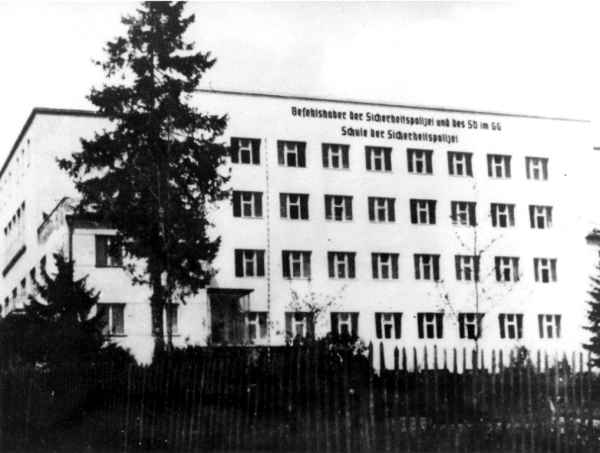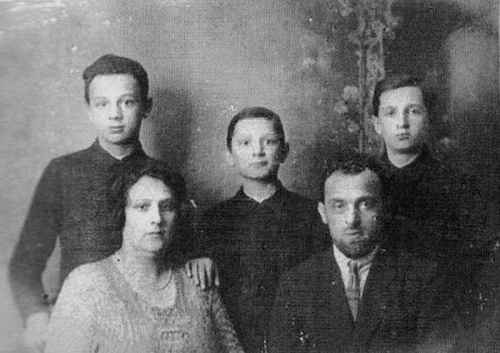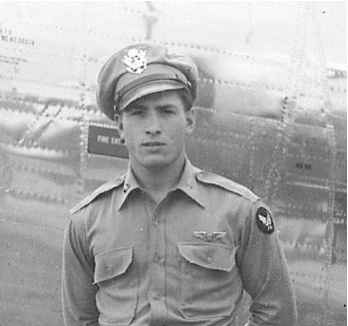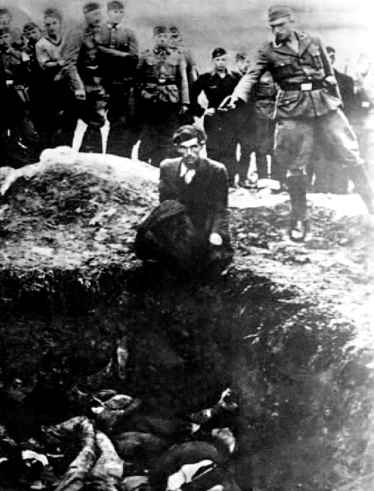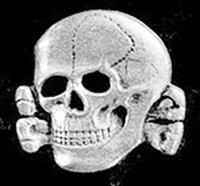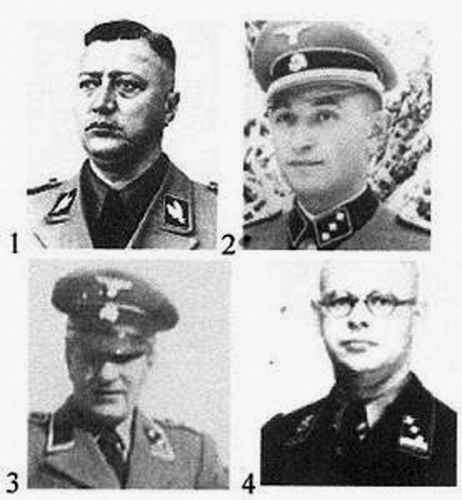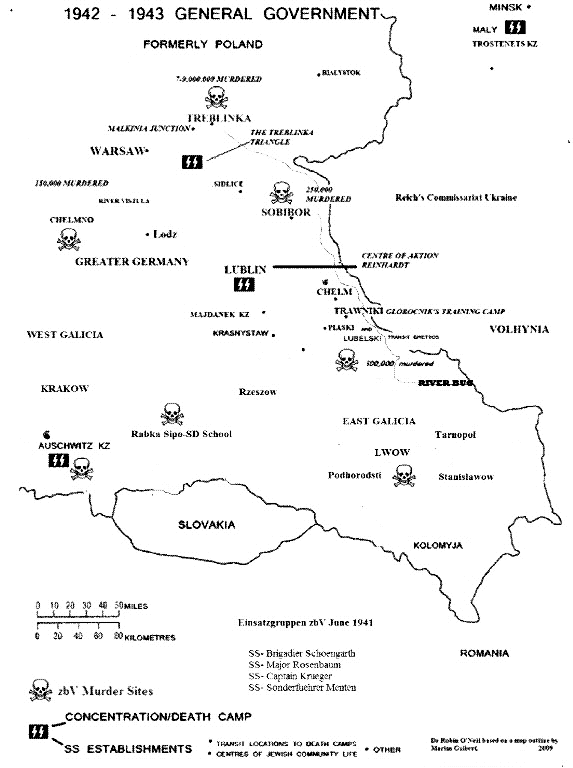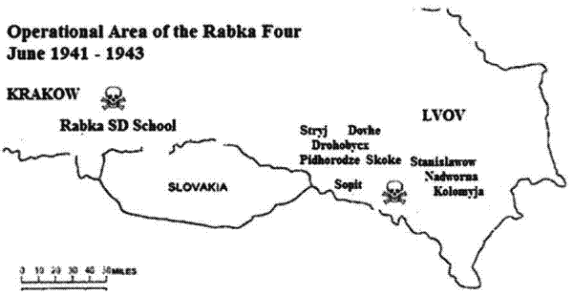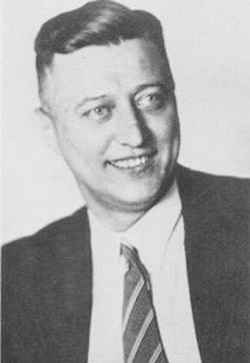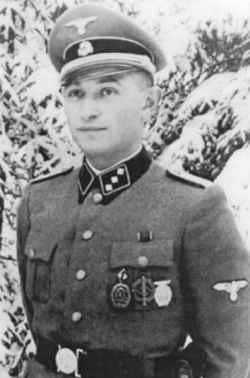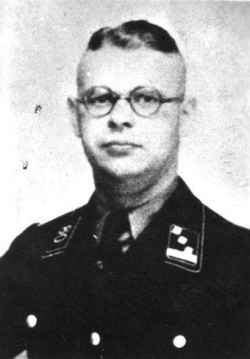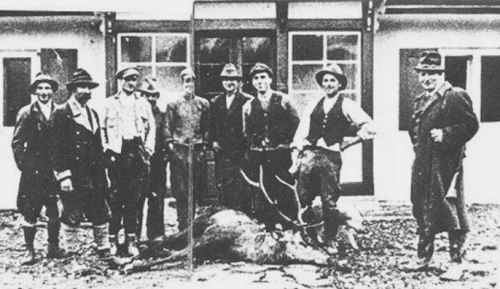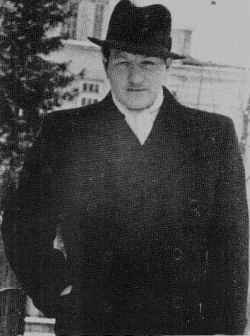Biography of the Author
The Author: Honorary
Research Fellow UCL,
Salisbury UK Dr Robin O'Neil
Dr. Robin O'Neil is a former police major crimes investigator who worked at the cutting edge of major criminal investigations in the United Kingdom and Central Europe. Formerly of Scotland Yard, the Metropolitan and Home Counties Police. service, he then took up the challenge of academia. After obtaining his Masterís and Doctorate with University College London, he now specializes in the investigation of Nazi war crimes and the destruction of the European Jewish communities 1933-1945. He is a regular lecturer at Universities in the United Kingdom, United States, Israel and Eastern Europe
|
[Page v]
Other Publications by the author:
Belzec: Stepping Stone to Genocide: Published by the Museum of Jewish Heritage: wshalewitz@mjhnyc.org; NY, 2008
Oskar Schindler: Stepping Stone to Life: Published by Susaneking.com NY, 2010
|
|
Frontispiece: Sipo-SD School, Rabka, Poland
by kind permission of Yad Vashem Photographic Archives
Note (Original photograph (1942). Translation: 'The School of the Commander-in-Chief of the Security Police and Security Services'). Displayed at the top of the building |
[Page vii]
...it must all be recorded with not a single fact omitted... and when the
time comes...as it surely will – let the world read and know what the
murderers have done.'
'Yidn, shreibt un farschreib'[1]
For the families Künstlich (Kynst – Australia) and Galle – (USA)...
wherever they are!
[Page ix]
In Memory
Mojżesz and Rachel Künstlich (Neé Scheer)
Both murdered at the Sipo-SD Police School,
Rabka, Poland – 1942
|
|
|
Figure 1: circa 1926:
With their three sons:
Eleizer, Benjamin and Efraim |
* * * *
And
2nd Lieutenant Americo S. Galle (USAF) Awarded: Air Medal
With 3 Oak Leaf Clusters, Purple Heart
Murdered by SS Security Forces at Enschede, Holland, 21st November 1944
|
|
|
[Page x]
* * * *
To all flyers who failed to return home as the result of the
Kugel Erlass ('Bullet Decree')
* * * *
'Old men forget: yet all shall be forgot, But they'll remember with advantages
what feats they did that day'
Shakespeare Henry V. 1V. 3
[Page xv]
Acknowledgements
No work of this nature would be possible without the full support of Historical Archives. I am indebted to the Yad Vashem Archives, Israel; the United States Holocaust Memorial Museum; the George C Browder Archive; the National Archives at Kew and the British Library; The Directors Villa Hoge Boekel, Holland. To personally thank the many individuals who have helped and contributed to my research over many years was an impossible task. To close friends, survivors of the Holocaust, Archivists, and Academia in general, I pay due acknowledgment.
However, special mention must go to Darren Jelley, Museum Director 493rd Bomb Group Archives, Debach, Suffolk; the United States Embassy, London; to Krystyna Kynst, Melbourne, Australia; Sara Schon, Israel; Pastor Werner Oder, Bournmouth, Dieter Pohl, Germany; the Authors: Malcolm MacPherson and Hans Knoop who brought the Podhorodze catastrophe to notice of the general public and finally; to my long suffering mentors: Professor Michael Berkowitz, Sir Martin Gilbert and the late John Klier, who have born their duties with some endurance and fortitude. Finally, special thanks are extended to my long term editor, friend and mentor, Professor of the English language (USA) Joyce Field who I first met in the old East Galician town of Lvov many years ago when the search for justice began.
[Page xvii]
Note by the Author
I was motivated to write this account some twenty years ago when several Jewish survivors of the German Security Services Training School at Rabka related their stories to me. At that time I had no idea where this would lead but as my investigations proceeded I was drawn further and further into a black hole, an unbelievable pit of horror and deprivation. It soon became apparent that under the cloak of war – personal vendetta, corruption, robbery and murder – this criminal virus spread out to other places and was now endemic among the SS leadership and their associates. When the war finished our protagonists, for a time, escaped immediate attention, but as the evidence emerged they were, one by one, tracked down and dealt with according to the law.
This kind of work and, indeed, this small book gives me no pleasure and in many respects grinds one down and makes one ponder whether it was all worthwhile, or indeed, necessary after all these years. On reflection I concluded that it was right for two reasons: to expose the suffering of the individual victims and bring some comfort and justice to those left behind; and secondly, by this research providing the details and circumstances of Americo S. Galle's untimely, violent and unnecessary death. Lieutenant Galle was a single man, a Latin Scholar and devout Catholic. Americo's father, Vincenzo Poggiogalle was born in Tagliacozzo, Italy, a small town in the province of Abruzzo. He was an immigrant from Italy and changed his name to Galle on arrival at Ellis Island in 1912. Americo's mother, Margaret, was born outside of Naples, Italy. She met. Vincenzo in New York where they married. Vincenzo, like most immigrants from Tagliacozzo settled in Yonkers, New York where Americo, his brothers' Irving, Salvatore and Vincent Jr. were born and raised. Lieutenant Galle initially lay in an unmarked and unidentified grave in a foreign field but is now safely among his friends in an American War Cemetery.
One plus that survives and rises above all else in this misery is the individual bravery of Mojżesz and Rachel Künstlich and that of Lt. Americo Galle. These
[Page xviii]
were exceptional cases where evidence of their conduct and bravery is corroborated by the very men who executed them.
For the first time I am able to show the world what happened to Lt Galle after leaving his damaged aircraft on that fateful day. Not only does the record show that he was killed in action but now, by this research, the circumstances surrounding his death.
One minus, alas – in spite of my best efforts and intentions to set out the day- today barbarity of these times, I doubt if it has been possible accurately to convey to the reader the realities. It was exceedingly difficult to describe truthfully, and with some clarity, the enormities of these crimes that quantitatively and qualitatively exceed human imagination.
There is more:
Having already included in the appendices a discussion programme regarding Pastor Werner Oder, I thought it was the best I could do in the circumstances and left it at that. However, on the day that I finalised this manuscript I received a telephone call from Pastor Werner requesting to see me to talk over his father's (Wilhelm) duties in the Police School.
We met and had an open, frank and friendly discussion which in many ways corroborated my own research: that his father was the SS 'execution' instructor at the school setting up mock and real situations using Jews who been brought into the School for this purpose. It was on these occasions I suggested, that his father had perfected 'shot in the neck' method, ('Genickschuss Experte')? This operational exercise was subsequentely practiced in the entire Reich and occupied territories. It was the method that had killed my airman, 2nd Lieutenant Americo S. Galle in 1944. When I discussed this and the murder of Mojżesz and Rachel Künstlich who had been executed at the School, Werner agreed that in all probability his father would have been supervising these incidents: 'that was his job', said Werner. Below: A photograph of a real life execution at Vinnitsa Ukraine in 1942 which had previousy appeared in a magazine co-written by Pastor Werner depicting the 'Genickschuss Experte' in action.
Robin O'Neil
Hon. Research Fellow,
University College London,
Salisbury, UK – 2011
[Page xix]
[Page xxi]
THE RABKA FOUR
INSTRUMENTS OF GENOCIDE AND GRAND LARCENY
A Warning from History
| Sipo-SD |
|
|
| SCHOOL
Befehlshaber der Sicherheitspolizei und des SD im GG Schule des Sicherheitspolizei |
|
|
| Figure 3:
1. SS – Brigadierfuehrer Dr. Karl Eberhard Schoengarth
2. SS – Untersturmfuehrer Wilhelm Karl Johannes Rosenbaum
3. SS – Schafuehrer Pieter Menten 'the Dutchman'
4. SS – Hauptsturmfuehrer Hans Krueger |
[Page xxiii]
Photographs Acknowledgements
| Photographs and documents come from the author's own collection (A), the Jewish Historical Institute in Warsaw (HIW); United States Holocaust Memorial Museum (USHMM); the Yad Vashem Institute of National Remembrance (YV); Villa Hoge Boekel (VH); Robson Books (RB); Sir Martin Gilbert (A. MG); Salisbury Journal (SJ); National Archives (NA): Littman Library (LM): Debach Museum (DM); Wikipedia Resources; Chris Webb & Carmelo Lisciotto Archival Resources: New Statesman (NS): Krystyna Kinst (KK)[2] |
| Figures: |
| 1. |
Mojżesz and Rachel Künstlich: (KK) |
| 2. |
SD Uniform insignia: (A) |
| 2a. |
Vinnitsa, Ukraine, 1942 (YV) |
| 3. |
Rabka Four: (YV) |
| 4. |
Map: Generalgouvernement 1942: (A. MG) |
| 5. |
Map: East and West Galicia: (A. MG) |
| 6. |
SS-Brigadier Karl Eberhard Schoengarth: (HEART) |
| 7. |
SS-Major Wilhelm Rosenbaum: (YV) |
| 8. |
SS-Captain Hans Krueger: (YV) |
| 9. |
SS-Sonderfuehrer Pieter Menten 1935: (ANP) |
| 10. |
Pieter Menten 1941: (De Telegraf) |
| 11. |
SS: Heinrich Himmler (YV) |
| 12. |
SS Reinhard Heydrich (USHMM) |
| 13. |
Figure Partition of Poland 1939: (A. MG) |
| 14. |
Sipo-SD School and Gestapo Interrogation Centre, Zakopane: (HIW) |
| 15. |
SS Hauptsturmfuehrer Wilhelm Rosenbaum: (YV) |
| 16. |
Map: Barbarossa 1941: (A. MG) |
[Page xxiv]
| 17. |
Wannsee Conference: Attendees (HEART) |
| 18. |
Dr. Marek Redner: Permit to Practice (A) |
| 19. |
Sipo-SD School 1942: (YV) |
| 20. |
School 1998: (A) |
| 21. |
SS Rosenbaum on horse Rabka 1942: (YV) |
| 22. |
Students at the School 1942: (YV) |
| 23. |
Staff Lecture 1942 and Ukrainian Students: (YV) |
| 24. |
Lucia Schon (centre: Rosenbaumís cleaner) (A) |
| 25. |
Arthur Kuhnreich Jewish Resident at Rabka: (A) |
| 26. |
Execution Tree Rabka: (KK) |
| 27. |
Simon Wiesenthal: (A) |
| 28. |
Selection: Krakow: (A) |
| 29. |
SS Sonderfuehrer Pieter Menten 1941: (RB) |
| 30. |
Pieter Menten in Vehicle Podhorodze: (YV) |
| 31. |
The Author Hans Knoop (ANP) |
| 32. |
Re Burial at Podhorodze 1976: (Novosti) |
| 33. |
Countess Karolina Lanckoronska (HEART) |
| 34. |
Pieter Menten c. 1985: (RB) |
| 35. |
Dr. Schoengarth |
| 36. |
B 17 Flight Formation 21 November 1944: (DM) |
| 37. |
Villa Hoge Boekel: (William Weavers) |
| 38. |
Entrance Gates to Villa: (Wim Hein) |
| 39. |
Forestry Track the Villa: (VR-Bayens) |
| 40. |
Death Warrant Dr Schoengarth: (NA) |
| 41. |
American Battle Monument: (USA Archive) |
| 42. |
Lt. Galle: Dog Tag (DM) |
| 43. |
Pasto Werner Oder and associate: (SJ) |
| 44. |
Rabka Cemetery (School): (A) |
| 45. |
Belzec Book Cover 1947: (LL) |
| 46. |
Author: |
| 47. |
Back Cover: Figure 44: 500 Złotych bank note (1940) |
[Page xxv]
Note on Language
The SS and the state bureaucracy employed elaborate titles and designations which can be confusing to anyone but the specialist. As far as possible these designations have been simplified and wherever possible the German original has been used followed by the English translation in parentheses.
Terminology was a crucial device of the Nazis. As Raul Hilberg writes: their policy was: 'never utter the words appropriate to the action'.[3] The euphemistic language spoken within the Nazi Police State conveyed a climate of 'order' and 'intention'. This is the language of deception that helped shape the pattern of society, pertinently explored by Hans Paechter[4] and Viktor Klemperer.[5] The Nazis thought up new terms and used old words contrary to their original meaning. By euphemistic presentation, they misled their enemies, victims, and those hovering on the periphery, to divert and obscure the most hideous of crimes.[6]
It is very easy to be drawn into the Nazi code of euphemistic language. Indeed, it is difficult to avoid it and mean what we say. This double meaning was introduced as the system of genocide was perfected, thus, from October 1941 onwards, we find: Judenaussiedlung (emigration of Jews), Judenumsiedlung (Jewish resettlement) and Judenevakuierung (evacuation) – all synonyms for mass murder. When Eichmann defined his purpose we find: Aussiedling (evacuation); Verwertung der Arbeiterscharft (utilisation of labour); Sachverwertung (seizure and utilisation of personal belongings); and Einbringung verborgener Werte und Immobilien (confiscation of hidden assets and real estate).
When the instruments of murder moved from the euthanasia programme and concentration camps we find abspritzen (to spray – administering a lethal injection), or Totbaden (death baths). The euphemistic bureaucratic terminology was perfected by the SD as the persecution progressed: Actionen (operations), Säuberung (cleansing), Sonderbehandlung (special treatment), Ausschaltung (elimination), or Exekutivmassnahme (executive measure). After each mass
[Page xxvi]
execution in Auschwitz, camp commandant Rudolf Hoess submitted a report to the RSHA in a disguised formula:… so und so viel Personen gesondert untergebracht worden seien (…such and such a number of people separated, or segregated). These terms create the illusion of a bureaucratic paper chase, not genocide, where euphemistic 'double-speak' was an essential ingredient in the Nazi war against the Jews. The illusion of 'plain speak' contaminated, and indeed indoctrinated, the minor functionaries caught-up in State racial persecution policies.[7] Any sense of moral perspective was abandoned to conceal the true meaning of the word employed.
Another aspect of this was the euphemistic jargon of the concentration camp guards, police and male psychiatric nurses. They used such terms as 'not worth keeping', 'treat' the child, 'processed', 'authorisation' 'put on the grill', which all simply meant 'to kill'. All those so engaged at every level of mass murder became used to communicating in this 'sanitised' language. Although it might appear a minor point, it had immense relevance in smoothing the day-to-day working in both the euthanasia institutions and the death camps.[8]
The euphemistic language was constantly being refined. When Eichmann's office was relieved of the task of compiling statistical reports pertaining to Reinhardt, these duties were passed over to Dr. Richard Korherr, the SS Chief statistician, who drafted a report for Himmler on the progress of the 'Final Solution'. He noted that 1,449,692 Polish Jews had already received Sonderbehandlung ('special treatment').[9] Himmler returned the document and demanded a more appropriate phrase, durchgeschleust (passed through), thereby suggesting that the numbers of Jews referred to in the report simply and safely passed through transit camps).[10]
Himmler was a past master of euphemistic language and used it continually. The only time he appears to have dropped this camouflage was in his speech in Posen in October 1943, when he spoke directly to his SS in a protected environment.[11] Historians too have differed over the exact terminology appropriate to defining the Jewish catastrophe.
[Page xxvii]
Geographic Aspects
Area of the Generalgouvernement incorporating East and West Galicia 1942
Generalgouvernement Area
|
|
| Figure 4: The Generalgouvernement 1941- 1943
|
[Page xxviii]
|
|
| Figure 5: East and West Galicia
|
The Austrians originally referred to Galicia as 'Galicia-Lodomeria' after they expropriated that territory from the Polish-Lithuanian Commonwealth during the First Partition of Poland in 1772. Over the years, the borders varied slightly, especially during the Napoleonic Wars, following which Krakow and the surrounding lands were eventually added to Galicia. Galicia became the largest province of the Austro-Hungarian Empire, and bordered Moravia in the west and the Ottoman Empire to the south. For a time, Bukovina was included in Galicia; however, this area today forms a part of Romania. Galicia was returned to Poland when the Polish Republic was re-established after the First World War.
Today, the eastern half of Galicia is part of the Republic of the Ukraine, while the Western half lies in the Polish Republic. The term Galicia therefore no longer describes an administrative or political region in either country. By far the largest proportion of the rural population in agricultural eastern pre-war Galicia was of Ukrainian nationality, followed by Poles and Jews, the latter dominating commerce and trade.
It was not until the German invasion of the Soviet Union that east Galicia was integrated into the Generalgouvernement, an area where all manner of
[Page xxix]
experiments directed at the Jewish population took place.[12] It was also the area where the most affluent Jews and the poorest lived alongside the wise men and the simple, the intelligentsia, artisans, beggars, and bankers alongside the Hasidim. Regardless of their social standing and circumstances, they all found their final resting places in Belzec, Sobibor and Treblinka. The region was a centre and spiritual home of the Diaspora, which was to have its heart torn out in the gas chambers of Belzec. Largely annihilated, the Jews of Galicia and their culture never recovered.
[Page xxxi]
Introduction
This research focuses on the murderous activities of senior officers of the German Security Services who, at the outbreak of war in 1939, were brought together at the newly established Sipo-SD School at Zakopane and later Bad Rabka, Poland. In June 1941, all education facilities of the School were suspended in preparation for the war against Russia when the School leadership were dispatched to other duties. Their activities continued in the provincial districts of east Galicia, where their unprecedented murderous actions wiped out the intellectual base of the Polish intelligentsia and Jewish community towns.
The Sipo-SD School, between 1941 and 1944, was where the Nazis turned a girls' school into a centre for training the Einzatsgruppen (death squads) and Special Agents operating throughout Eastern Europe. They rounded up Jews and Poles and shot them in the woods behind the School. Children were used as live targets for machine-gun practice. It was here that SS-Major Rosenbaum and his staff perfected and developed the Genickschuss method of shooting victims in the nape of the neck – considered the most efficient means of execution other than the gas chambers. In 1944, this method also became known as the Kugel Erlass ('Bullet Decree'), which was widely adopted on Hitler's orders to deal with Allied airmen who parachuted to safety over occupied territory.
For the duration of the war, the 'Rabka Four', in some way or other, used the facilities of the establishment of the Sipo-SD School as a centre for their unlawful activities. All four protagonists remained in contact even after the war.
Each is ultimately subjected to war crimes investigations and is appropriately dealt with within the War Crimes Judicial System.
Finally, as the result of the 'Rabka Four's' activities, a high percentage of Jews within the East and West Galicia were deported to the Belzec death damp never to return. Very few escaped from the camp to inform the world of the happenings within. One such escapee, Rudol Reder, published his memoir Belzec in Krakow, 1947. This personal account is attached as an appendix.
[Page xxxii]
A brief introduction to our 'Rabka Four' opens with a brief summary of their beginnings and unfolds further with the passage of time. This was an exceptional period in our history and clearly, the very stuff of life was precariously balanced on the edge, for both sides.
[Page xxxiii]
1. SS - Brigadier Dr. Karl Eberhard Schoengarth
|
|
| Figure 6: SS - Brigadier Dr. Karl Eberhard Schoengarth
|
Promotions
- SS-Untersturmfuehrer – November 9, 1936
- SS-Obersturmfuehrer – January 30, 1938
- SS-Hauptsturmfuehrer – April 20, 1938
- SS-Sturmbannfuehrer – August 1, 1938
- SS-Obersturmbannfuehrer – September 10, 1939
- SS-Standartenfuehrer – January 1, 1940
- SS-Oberfuehrer – January 30, 1941
- SS-Brigadefuehrer und Generalmajor der Polizei – January 30, 1943
|
Notable decorations
- War Merit Cross First Class with Swords
- War Merit Cross Second Class with Swords
- SS-Ehrenring
- Reichs Sport Badge
- Honour Sword of Reichsfuehrer SS
|
[Page xxxiv]
Berhard Karl Schoengarth was born in Leipzig on 22nd April 1903. He studied law, achieved a doctorate and first joined the Nazi Party as a university professor in Leibnitz. He rejoined the NSDAP in 1933 and joined the SS on 1st March 1933 as well as the Prussian Gestapo in 1935. From November 1935 to 1936 he was assigned to the press section in the Berlin Gestapo and during the first half of that year also acted as a political lawyer.
He was in charge of the Gestapo office in Arnsberg from May 1936 through 1937 and was commissioned as an SS-Untersturmfuehrer on 9th November 1936 when he was assigned to the SD Hauptamt (later the RSHA), from November 1936 to October 1939. He was promoted to SS-Obersturmfuehrer on the 30th January 1938, to SS-Hauptsturmfuehrer on the 20th April 1938 and to SS- Sturmbannfuehrer on the 1st August 1938. Four weeks later he was promoted to SS-Obersturmbannfuehrer on Himmler's orders. Dr. Schoengarth headed a number of Gestapo offices in Bielefeld during 1937-1938, then Dortmund in the first quarter of 1938 and Munster. He was the Senior Inspector of the Sipo and SD in Dresden from early October 1939 until he went to the Generalgouvernement in January 1941 and to supervise the newly re-constructed Sipo-SD School at Bad Rabka.
Dr. Schoengarth was promoted to SS-Colonel on the 1st January 1940 and was also made an Oberst der Polizei on the 1st March 1941, based in Krakow where he was Senior Commander of the Sipo and SD until mid-June 1943. In July 1941, Dr. Schoengarth led an Einsatzgruppen in Poland which saw service in Eastern Poland and Western Belorussia. In total, his command was responsible for murdering approximately over 17,000 victims at the time it was disbanded in the autumn of 1941, when he returned to Krakow to head the security police and direct operations in the reorganisation of the Sipo-SD School at Rabka. He was one of the top five SS commanders who worked very closely with Himmler and Heydrich and was a leading contributor at the Wannsee Conference on 20th January 1942, concerned with the Jewish Question.
[Page xxxv]
2. SS-Untersturmfuehrer Wilhelm Karl Johannes Rosenbaum
|
|
| Figure 7: SS-Untersturmfuehrer Wilhelm Karl Johannes Rosenbaum
[13]
|
Wilhelm Rosenbaum was born on the 27th April, 1915 in Prenzlauer Berg, Berlin. His father, Peter Rosenbaum was a municipal worker at the central covered market at the Alexanderplatz. His mother died when Wilhelm was just one year old. The father re-married which brought forth the stepbrother of Wilhelm, Franz, born in 1910. He has been listed as missing since the Second World War. The second marriage was dissolved after three years.
On his 18th birthday, the 27th April, 1933, he was admitted to the NSDAP; and applied for work with the German Work Front and was accepted on the 5th August, 1933; he dealt with the postal dispatch office and other menial tasks. From the 1st November, 1934, until September, 1935, he served voluntarily with the 'Reichswhr', namely the 12th infantry-regiment Dessaue-Halberstadt. He has unpleasant memories of this period. The training was hard and the soldiers were often harassed and excessively put through the mill. He left the 'Reichswehre' as a Lance Corporal.
[Page xxxvi]
With the assistance of the SA, Wilhelm found a job as clerk at the SS-Head Office. Again he was given menial tasks, probably just within his capabilities. He remained there until the spring of 1936. On advice he applied for, and was accepted by the Head Office of the 'Staatspolzei', Berlin. He worked for Department 1, (Management and Law) as a police office clerk where he registered reports of weaponry and confiscation issues. He had no decision- making authority.
SS-Career Commences 1936
Based upon his employment at the head Office of the security police, Wilhelm was taken on temporarily (on probation) by the SS on the 1st July, 1936, a critical time at the onset of Security Services amalgamations. Wilhelm had married Hedwig Bober in August, 1937; on the 22nd June, 1938, their daughter Ellen was born. The marriage was not a success and they were divorced in 1940 by mutual consent.
With the outbreak of war against Poland, Rosenbaum, as a member of the SS, was transferred to the Inspector of the Security Police in Oppein. He was issued with a grey SS-uniform of the 'Oberschafuehrer' rank and joined the 'Dr Schafer' task force which consisted of some 60-80 men. This task force was commanded by SS-Obersturmbannfuehrer' Sens. This unit was to fight partisans and find 'insurgents' and render them harmless. After a short stay in Oppein, the task force operated in Tschenstochau and then moved to Krakow. In Krakow Rosenbaum was transferred to Sipo-SD squad that had to shoot enemies of the Reich who had been condemned by court martial. The officer in charge was Sipo-SD SS-Hauptsturmfuehrer Hans Krueger.[14] Krueger, a ruthless and brutal man, obsessed with national-socialist ideas, made an immediate impression on the 24-year-old Rosenbaum.
In early November, 1939, Rosenbaum was moved to the department of the Commander-in-Chief of the Security Police and Sipo-SD (BdS) in Krakow, whose leader was SS-Obergruppenfuehrer Dr. Karl Eberhard Schoengarth. Under the direct leadership of Hans Krueger (Schoengarth's deputy), Rosenbaum and his squad were mobilised to force their way into Jewish homes to collect money and 'contributions' from the Jews of Krakow.
In December, 1939, Rosenbaum was commissioned to take over the re- organisation of a School of the Commander-in-Chief of the Security Police
[Page xxxvii]
(Sipo-SD) in Zakopane as 'Wirtschaftsfuehrer' (economic leader). The commandant of this School was the aforementioned Hans Krueger.
In July, 1940, Rosenbaum was at that time on holiday. The School was transferred from Zakopane to Bad Rabka. He received orders to terminate his leave and go direct to Bad Rabka to take over duties of SS-Untersturmfuehrer and Police Secretary to the newly located School. He was now deputy to Hans Krueger. The Rosenbaum-Krueger administration was short lived. Transfers, promotions and sideways moves were numerous. Krueger was seconded to the office of Dr. Schoengarth in Krakow, and Rosenbaum took his place though without promotion.
Rosenbaum was like a rabbit caught in the headlights of a car when he was in the presence of Dr. Schoengarth.[15] Rosenbaum idolised him and became literally absorbed by him, as he had Hans Krueger; this may have been a result of his unlucky childhood from which sprang a longing for authority and a role model. Dr. Schoengarth quickly turned into his Fuehrer – a father figure to whom he submitted himself blindly and unconditionally. Therefore, he carried out his orders and directions, so to speak, automatically and without any forethought; on top of this, he had the tendency to interpret every move, every remark and comment of Dr. Schoengarth as an order. He made a diligent effort to receive a 'good mark' and deserve the high estimation of his Commander-in-Chief. His efforts to win the favour of Dr. Schoengarth led to effeminate subservience. He readily responded to each wish from his superior's mouth, hanging onto every word, serving him blindly and zealously as soon as he came back to Bad Rabka.
Rosenbaum did not always receive the appreciation and recognition he sought. In spite of everything, he remained, in the eyes of Dr. Schoengarth, the 'foolish kid' and 'bootjack'. Whenever Dr. Schoengarth showed his dissatisfaction with him, e.g., criticised loudly that the served food was not enjoyable, the Schnapps too warm etc., Rosenbaum was deeply hurt and became depressed. When criticised, Rosenbaum always felt this to be an outrageous insult, had a self- pitying reaction and immediately broke out in tears whenever Dr. Schoengarth criticised him. The situation even sank to the level of perversion in the sense that Rosenbaum considered it an honour when Dr. Schoengarth treated him in this manner.[16]
After a bizarre incident, when Rosenbaum presented Dr. Schoengarth with a brace of geese in order to please him, there were terrible repercussions. Rosenbaum had mistakenly taken the geese from property belonging to the
[Page xxxviii]
Higher SS Police Fuehrer, F.W. Krueger (not Hans Krueger) who was informed of the incident. Rosenbaum received a 'tongue lashing' from Dr. Schoengarth over the incident and as a result sank into further depths of depression and cried on the shoulders of a comrade, SS-Unterscharfuehrer Kluck.
All these humiliations did not result in Rosenbaum's breaking away from his inner fixations on Dr. Schoengarth as role model and father figure. His idolatry would remain intact, until reasons led to the separation of the roads of destiny that each man travelled. To outsiders, Rosenbaum, the small Untersturmfuehrer, became someone respectable, as a personal confidant and indispensable aid and organiser. Dr. Schoengarth, the big benefactor, had inadvertently turned him into a little god while despising him at the same time.
Oskar Schindler joins the throng
In April, 1941, Rosenbaum and his immediate staff were withdrawn from the School and seconded to Dr. Schoengarth's office in Krakow. Rosenbaum was given the task of organising an officers' club. It was at the officers' club that he came into contact with the art expert Pieter Menten ('the Dutchman') which was the start of a lasting friendship. Another welcome associate who frequented the club was the Krakow factory owner, Oskar Schindler. Rosenbaum remained in Krakow until receiving orders in June, 1941, to join the 'Einsatzcommando' zbV of Dr. Schoengarth with whom he remained, seeing service in Galicia, returning to take charge of the Sipo-SD School in Rabka in the autumn of 1941.
[Page xxxix]
3. SS Captain Hans Krueger
|
|
| Figure 8: Hans Krueger[17]
|
SS -Captain Hans Krueger was undoubtedly the right man for the job: he had joined the SA in 1929 at the age of twenty and was thus a seasoned 'alter Kaempfer (Old Soldier).' While growing up in his hometown of Poznan, he had seen the German-Polish 'cultural struggle' first-hand; together with his parents, he had been expelled by Poles in 1918. Krueger rose rapidly in the SA ranks. Instead of working in agriculture, for which he had specific training, he took over as leader of a SA 'Stormtrooper unit'. Shortly after the Nazis seized power in January 1933, Krueger was soon active in 'combating adversaries', having been appointed head of the Political Section in the Oranienburg concentration camp. After the Roehm Purge in June 1934, and the subsequent disarming of the SA, he was also demoted, ending up as a section head in a labour office.
Krueger did not return to the Nazi apparatus of repression until 1939, joining the Gestapo as an official in his native Posen and then in Krakow. Here, too, his Nazi fanaticism and brutal ruthlessness did not go unnoticed, and the Krakow KdS named him director of the Sipo-SD School in the town of Zakopane. There he trained Ukrainians and others as future Sipo-SD personnel, men whom he would later command in Stanislawow. Krueger's big chance came with the attack on the Soviet Union on the 22nd June, 1941, when he joined the zbV Commando unit as deputy to Dr. Schoengarth on their drive into Lvov.
[Page xl]
4. Pieter Nicolaas Menten
|
|
| Figure 9: Pieter Nicolaas Menten (right) with the Villagers pre war
|
On the 22nd May, 1976, Holland's biggest newspaper, De Telegraf, described a remarkable venture planned by the art-auctioneers Sotherby- Mak van Way. Pieter Nicholaas Menten, one of the richest men in Holland, was selling his Amsterdam apartment. He had to dispose of 425 pictures and other objets d'art for which there was no room in his country house already crammed with other treasures.
Menten was quoted as saying that his fortune had first been acquired in pre-war Poland; he had been ruined by the Nazi occupation, but had restored his finances, and his art collection. What Menten didn't say was that before the war he was working as an agent for the German Sipo-SD-Abwehr in Southern Poland and Galicia.
Pieter Nicloaas Menten was born on the 26 May 1899, in Amsterdam into a wealthy Amsterdam family. He claimed descent from the founders of Van den Bergh's (Unilever), claiming that his father had been in Royal Dutch Petroleum but broke away after the Shell take-over. The truth was not to become apparent until well after the war. In 1980 at the conclusion of a protracted War Crimes Trial, it was disclosed that his predecessors had never had anything to do with Shell or Unilever.
His father had been a dealer in rags and waste paper, the company was named Menten and Stark and his grandfather had been a butcher's assistant. Pieter had a
[Page xli]
brother Dirk, two years younger, who had joined the family's waste paper business.
On his father's death in 1922, Menten broke away from the family empire and established a business in Danzig under the name 'Menten and Stark.' With his business activities and deals of a dubious nature, he became a millionaire overnight, and the largest timber trader between Holland and Eastern Europe. Most of his acquired wealth in Danzig was the result of fraudulent activities and as a result he fled with his wife to Lvov where they occupied a small flat.
Pieter Menten soon developed an extensive export trade in Dutch products to Poland. He moved to East Galicia in 1923 (then in Poland and later part of Soviet-Ukraine), where he became a wealthy landowner and businessman.
Described as mild-mannered and quiet, he developed a deep grudge against a prominent neighbouring Jewish family over a business dispute.
In Lvov, Menten was introduced to the Jew Isaac Pistiner who had two large estates that he had purchased from Princess Maria Lubomirska. Both men went into partnership, Menten renting from Pistiner the timber rights and the hunting lodge of the Sopot estate and almost immediately acquired the stance of benefactor and employer of the local peasants. The 'Dutchman' or 'Petro Menten' as he was known throughout the Stryj valley, became 'family' to Frieda and Isaac Pistiner and their eight children. This fatherly figure extended to relatives of the Pistiners, in particular to a young boy named Lieber (Bibi) Krumholz.
|
|
| Figure 10: The Dutchman: Pieter Nicolaas Menten: Art Expert 'V' Agent working for the German Security Services 1934 – 1943
|
[Page xlii]
Krumholz had been born in Lvov, now the Western Ukraine which used to be Eastern Galicia in pre-war Poland. His uncle, Isaac Pistiner, an industrialist who owned large forests in the Carpathian foothills, had a county house at Podhorodze – a village inhabited by Ukrainian peasants and Jews, where the Poles were the policemen, officials and foresters.
Pieter Menten befriended the young impressionable 'Bibi' Krumholz and they would often be seen together in their walks around the woods and fields in the Stryj valley. The Dutchman and Bibi Krumholz had become inseparable and remained so until Bibi Krumholz left Podhorodze for Palestine on the 24 October 1935. Bibi Krumholz took the name Chaviv Kanaan and kept in touch with his family by letter, also with postcards to his uncle Pieter Menten. A regular correspondence was maintained for years, and the dialogue ended when Poland was partitioned in 1939.
In 1935, Poland's hyper-inflation was nearly as bad as Germany's and provided rich opportunities for anyone with ready Dutch guilders. Pistiner, now sorely pressed for cash, was obliged to sell the Sopot estate to his partner Pieter Menten. Pieter Menten and his wife had become prominent among the Polish landowners and Jewish timber merchants around Lvov, and did many deals, some of a dubious nature with the Jew Isaac Pistiner. But also in 1935 Menten and Pistiner quarrelled, this time the basis of the dispute being a shady land and property fraud on Menten's holdings in the Stryj valley allegedly committed by Pistiner on Menten.
A bitter legal fight between the two men ensued and never abated. Meanwhile Menten had established his position in Lvov society. He became a naturalised Pole and also the honorary Dutch consul for Krakow. It was in this capacity he met Princess Juliana of the Netherlands, arriving in 1937 for a Carpathian honeymoon with her German husband Prince Bernhard. From 1936, the Sipo-SD and the Abwehr had been penetrating and recruiting sympathisers of the OUN movement.
The Menten case reflects the procedures adopted by the SD when recruiting 'V'- agents. Pieter Menten is pertinent to this study for the following reasons: it discloses the methods of counterespionage operating by Sipo-SD and Abwehr on the borderlands of the Reich. As all agents have to undergo training at some stage, we may presume that Sipo-SD training establishments in Germany (probably Berlin Greenwald) had some impute to field officers so engaged.
[Page xliii]
With the occupation of Poland, Sipo-SD were very quick to set up other training establishments of excellence, i.e., Zakopane and Rabka.
The above four individuals had come together in June 1941, at the commencement of the German-Russo-war where, in the ensuing months and years, they would cause havoc: pillaging, robbing and mass murder. Their subsequent background will emerge as we progress.
[Page xlv]
Uniformed and Non-uniformed German Police Ranks and Equivalent
Ranks in the SS and the U.S. Army
| Security Police |
Uniformed Police (Orpo) |
SS |
U.S. Army |
| Kriminalassistent |
Zugwachmeister |
Oberscharfuehrer |
Staff sergeant |
| Kriminaloberassistent |
Hauptwachtmeister |
Hauptscharfuehrer |
Technical sergeant |
| Kriminalsekretär |
Meister |
Sturmscharfuehrer |
Master sergeant |
| Kriminalobersekretär |
Leutnant |
Untersturmfuehrer |
Second lieutenant |
| Kriminalinspektor |
Oberleutnant |
Obersturmfuehrer |
First lieutenant |
| Kriminalkommissar |
Hauptmann |
Hauptsturmfuehrer |
Captain |
| Regierungs-und Kriminalrat |
Major |
Sturmbannfuehrer |
Major |
| Oberregierungs-und Kriminalrat |
Oberstleutnant |
Obersturmbannfuehrer |
Lieutenant colonel |
| Regierungs-und |
Oberst |
Standartenfuehrer |
Colonel |
| Kriminaldirektor |
Oberfuehrer |
|
|
| Kriminaldirigent |
Generalmajor |
Brigadefuehrer |
Brigadier general |
| Reichskriminaldirektor |
Generalleutnant |
Gruppenfuehrer |
Major general |
This material is made available by JewishGen, Inc.
and the Yizkor Book Project for the purpose of
fulfilling our
mission of disseminating information about the Holocaust and
destroyed Jewish communities.
This material may not be copied,
sold or bartered without JewishGen, Inc.'s permission. Rights may be
reserved by the copyright holder.
JewishGen, Inc. makes no representations regarding the accuracy of
the translation. The reader may wish to refer to the original material
for verification.
JewishGen is not responsible for inaccuracies or omissions in the original work and cannot rewrite or edit the text to correct inaccuracies and/or omissions.
Our mission is to produce a translation of the original work and we cannot verify the accuracy of statements or alter facts cited.
 The Rabka Four
The Rabka Four
 Yizkor Book Project
Yizkor Book Project
 JewishGen Home Page
JewishGen Home Page
Yizkor Book Director, Lance Ackerfeld
This web page created by Lance Ackerfeld
Copyright © 1999-2026 by JewishGen, Inc.
Updated 8 Dec 2011 by LA

